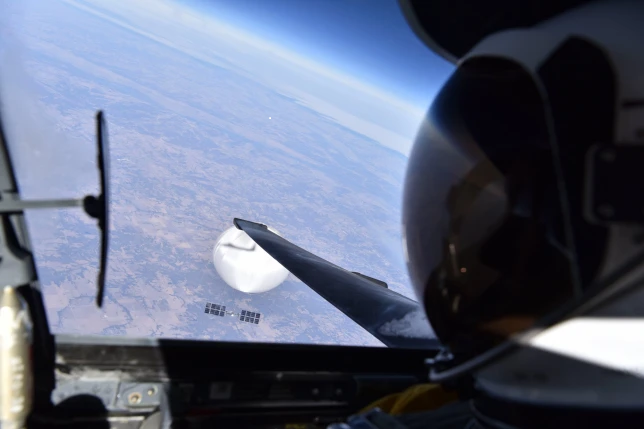2 March 2023
Up, Up and Away
by Paul Branch

So sang the pop group 5th Dimension, way back in 1967. A tuneful little ditty conjuring up calming images of a peaceful ride through the skies in the company of a loved one. Fifty-five years on, and along comes a US Air Force F-22 jet armed with sidewinder missiles.
“Would you like to ride in my lovely white balloon?
Way up in the air in my Chinese white balloon?
Up, up and away in my beautiful, my beautiful balloon …” BANG!
Luckily no one was injured as a US missile ripped into the Chinese balloon gently floating in American airspace. But thoughts of a planned romantic encounter between American and Chinese diplomats quickly flew out the window, deflating any hopes of a thaw any time soon in the increasingly frosty relations between the two superpowers. Instead it encouraged a further anti-Western cosying-up between Beijing and Moscow, just what the world didn’t need.
It took no time at all for the origin of the balloon to be pinpointed, even before it had been shot down and the debris examined, giving the US government cause to claim bitterly that this was an intrusive Chinese surveillance vehicle up to no good. Which begs the question as to what gave the game away. None of the airborne photos indicate a large neon “MADE IN CHINA” label. No doubt after recovery there was a lot of Chinese electronics on show … but open up any modern piece of gadgetry and you’d find the same. One theory is that the CIA had prior knowledge of the surveillance programme through their network of deep intelligence contacts but hadn’t thought to share the information earlier with their mates in Defense. The aggressive knee-jerk reaction that followed was then merely an extension of the initial communications cock-up … but we’ll probably never know.
With the discovery of three more balloons (plus other strange unidentified objects) the Chinese backed away from their initial “nothing to do with us” outright denial, to admission of ownership and a grudging apology for scientific weather balloons which had been blown off course and had unintentionally wandered into US (and Canadian, and Colombian) airspace. Inexplicably but still accidentally the objects had lingered awhile above a few particularly sensitive locations housing defence establishments. China counter-claimed that its own airspace had been infringed in the past by numerous US balloons, to which a sensible diplomatic blind eye had been turned. “Rubbish” retorted the Americans – 1) these Chinese balloons are propelled and steered, so they’re very unlikely to just drift off course; 2) we don’t do balloons; and 3) we’re gonna take yours down. Bang! Cue outrage all round: the cancellation by the US of potentially ground-breaking negotiations in Beijing, and accusations by China of unnecessarily alarming over-reaction by the Americans. Not a great outcome then.
So why all the fuss? Surely a balloon is no better than all the spy satellites and aircraft roaming the skies. And there can’t have been many previous incidents, otherwise they would have been picked up by the US defence radar systems, …. wouldn’t they? But apparently life is not that straightforward.
The Chinese balloons were drifting/hovering at between 55,000 and 85,000 feet altitude, loitering with apparent intent and thus posing a threat to US national security. They were duly shot down, but only once they’d been left to float into safe areas above water. These vehicles had a much better view of what was happening down below than any orbiting satellite – they were considerably closer than geostationary satellites 23,000 miles above the earth, and spent a much longer period above locations of possible interest than relatively fast-moving aircraft, or even low orbiting spacecraft 500 miles up. So they had a real and unique additional surveillance benefit, if that’s what they were really doing.
The first Chinese balloon was originally spotted visually by a regular USAF U-2 patrol aircraft (still in service since the ill-fated 1960 Russian overflight by CIA pilot Gary Powers), and not detected by any fancy defence radar system. Such electronic systems are tuned to identify incoming fast-moving enemy missiles or aircraft, not slow-moving balloons at relatively high altitude. The balloon structure itself could also pose problems for radar detection. Following the experience of the first balloon and with the benefit of some analysis, the radar systems were realigned and soon identified three more large balloons with huge payloads, and other airborne objects the Americans didn’t know were there.
The political conclusions drawn from this revelation were varied. Firstly that the foreign surveillance must have been going on for quite a while, undetected above the normal radar screens. From this the Biden administration was able to claim that they had succeeded in identifying and dealing with the security threat where their Trump-led predecessors had patently failed. The Republicans countered with the accusation that the aerial incursions once detected had been allowed to continue for far too long before being eliminated, although given the size and weight of the balloons it does seem reasonable to blow them up in relative safety over water.
As they appeared to have no idea this balloon surveillance was going on, it would be logical to surmise that the US has no equivalent spy technology, otherwise they would have been aware of the threat and adopted appropriate counter measures. Thus the Chinese claim that their territory had previously been infringed by US balloons was apparently misguided. However, balloon surveillance is not a new phenomenon – it’s been around for 200 years or so, with increasingly sophisticated technology, so it sounds a trifle disingenuous of the Americans to assert that they know nothing.
Acknowledging the gap in US security awareness, the incident is being given high-profile attention in Congress with an urgent review of lessons learnt and what to do about them. One aspect for consideration follows from the non-balloon objects which were destroyed by USAF fighter jets without being identified but which were deemed a safety threat to commercial air traffic. These are thought to have been either private industrial scientific measuring vehicles or someone just flying a kite for laughs. Having missed with the first attempt, it took another shot with a $400,000 sidewinder missile to down one of them, which doesn’t look good on the DoD budget, so either more target practice is needed for the pilots or a different (cheaper) calibre of missile.
Also in the thoughts of the Biden administration is the lack of an international convention regarding sovereign airspace: how to define it, how to protect it, and under what circumstances should protection measures become increasingly aggressive. Airspace is currently regulated nationally, with the limits usually defined in relation to aircraft flight paths and altitudes, applicable up to 40,000 feet or so for commercial airliners whereas 65,000 feet is not uncommon for military aircraft. Low orbiting and geostationary satellites tend to be excluded from concern, but other airborne objects offering a perceived security risk are fair game.
On a more down-to-earth note, in the UK if you own the freehold of your home, you’re entitled to enjoy the space 50 metres above your property. But taking a pot shot at overflying drones is definitely not allowed, even if they’re a nuisance – you might miss and risk bringing down an aircraft, or the falling debris might cause damage to life or property on the ground. Or you might start WW3. So beware.


